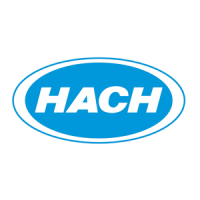45
SECTION 3, continued
refractive index of the suspended particles. Excessive ultrasound
application may alter particle size and shape, thus changing sample
turbidity. In some cases, ultrasound may impede air bubble removal by
fracturing the bubbles, making degassing more difficult.
The basic procedure for an ultrasonic bath is:
1. Fill a clean sample cell to the line with sample. Leave uncapped.
2. Immerse the cell (
1
/2 to
2
/3 immersed) in an ultrasonic bath and
allow it to stand until visible bubbles are expelled.
3. Remove the cell and replace the cap. Thoroughly dry the cell.
Apply silicone oil as directed in Section 3.1.1 on page 35.
The time necessary to expel bubbles may vary from a few seconds to a
minute or more. To avoid excessive application of ultrasound:
1. Apply ultrasound until all visible bubbles are absent.
2. Measure the sample turbidity.
3. Apply ultrasound for a short time period and again measure
turbidity.
4. Continue for several repetitions, noting the treatment time and
turbidity readings.
If turbidity begins to increase instead of decrease, the ultrasound waves
have probably started to alter the suspended particles. Note the time it
takes for this to occur and record it as the maximum time limit for
ultrasonic treatment.
3.2.4.4 Application of Heat
Gentle heating may be helpful for degassing some very viscous samples
when combined with application of vacuum or ultrasound. Heat may
change the characteristics of the suspended particles and cause volatile
components to come out of solution. If heat is necessary, heat the
sample only until degassing occurs.
1. Prepare a warm water bath and partially immerse the filled sample cell.
2. Use the shortest time necessary for expelling visible bubbles.
3. Cool sample to original sample temperature before taking
measurements.

